Sicilian Grape Must Pudding (mostarda di uva) is an ancient recipe prepared during the grape harvest season. This unique pudding is made with freshly pressed grape must, flavored with cinnamon and topped with toasted chopped nuts. And most importantly, it contains no sugar whatsoever!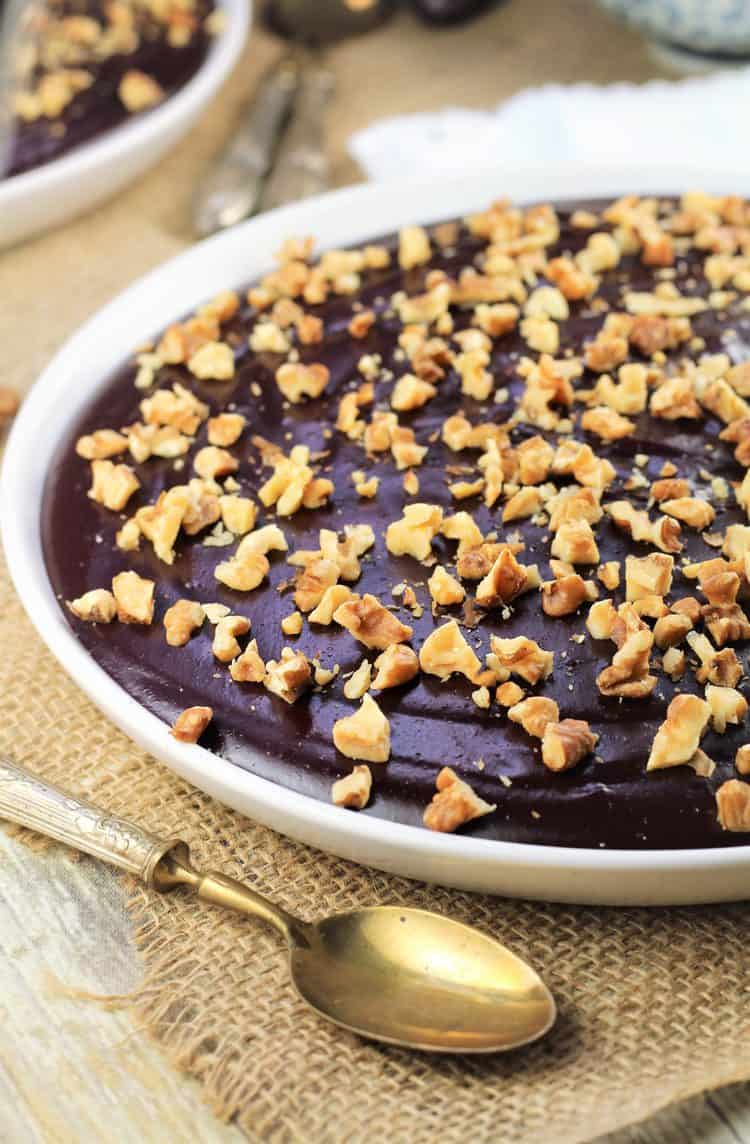 With just one bite of this dish, I was transported back to my childhood. It was just as I remembered it, tart and not too sweet, smooth and silky and a bit of crunch due to the toasted nuts.
With just one bite of this dish, I was transported back to my childhood. It was just as I remembered it, tart and not too sweet, smooth and silky and a bit of crunch due to the toasted nuts.
But before I tell you all about this recipe, I am curious to know if anyone knows of Sicilian grape must pudding (mostarda di uva), or a farinata as we call it in our dialect. If you have heard of this recipe please let me know by commenting below!
Once you've obtained the grape must necessary for making this recipe, it's really quite simple. Made up of only four ingredients: grape must; cornstarch; cinnamon; chopped nuts as a garnish and absolutely no sugar whatsoever! For those of you who are not familiar with this recipe, allow me to explain.
What is Sicilian Grape Must Pudding?
This is an ancient Sicilian recipe that was prepared during the grape harvest (la vendemmia) each year. Freshly pressed grape must (before it begins the fermentation process thus turning it into wine) is used to make this pudding like dessert.
The grape must is boiled until reduced by half and then allowed to completely cool. Once cooled, cornstarch and cinnamon are stirred in and then brought to a boil until thickened. The pudding is poured onto plates and topped with crushed nuts such as walnuts, almonds, hazelnuts or pistachios. It is placed in the refrigerator to cool and set before it is served.
I also just learned of an interesting variation from my mother. A farinata was left out to dry in the sun for a few days and then cut into squares. This allowed it to be stored long term and was served as a special treat. I can imagine this was probably similar to gummies! Note: I am trying to dry out my own but of course since we don't have access to Sicilian sun I have mine on a table by the window where lots of sunshine is pouring in. I'll let you know how it turns out!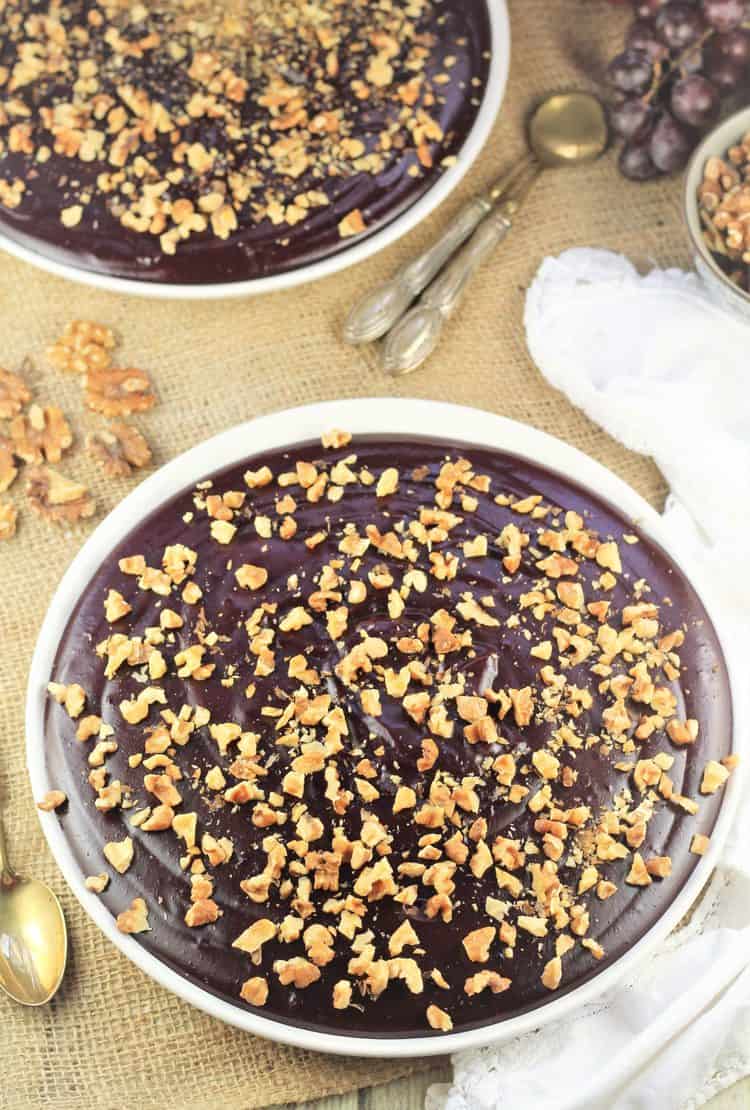
What is this dish called in Italian?
After much research looking for any evidence of something called farinata online, I came across similar recipes referred to as "mostarda di uva". Interesting, however, my family has never called it as such. This is not to be confused with the mostarda prepared in northern Italy which resembles a chutney.
I also learned that in Sicily the grape must was boiled with ashes added to the mixture and then strained. Apparently, the ashes served to reduce the amount of acidity in the grape must. Fascinating!
In the case of my family's dialect, my mother clarified that the word farinata refers to flour (farina in Italian) because originally the pudding was thickened with flour instead of cornstarch. It reminds me of my mother's zuppa inglese recipe, or crema as we call it, also thickened with cornstarch.
Origins of this recipe
This dish was prepared only by my maternal aunt, Zia Carmela, each year when my uncle made wine. Individual plates of this beautiful deep purple colored farinata were then distributed to family members. My mom never made this dish and unfortunately the recipe was lost with my aunt.
I pieced this recipe together with the help of my cousin in Sicily, one of my mother's cousins in Australia as well as my mother's recollections of my nonna making a farinata in Sicily. Thank goodness for social media!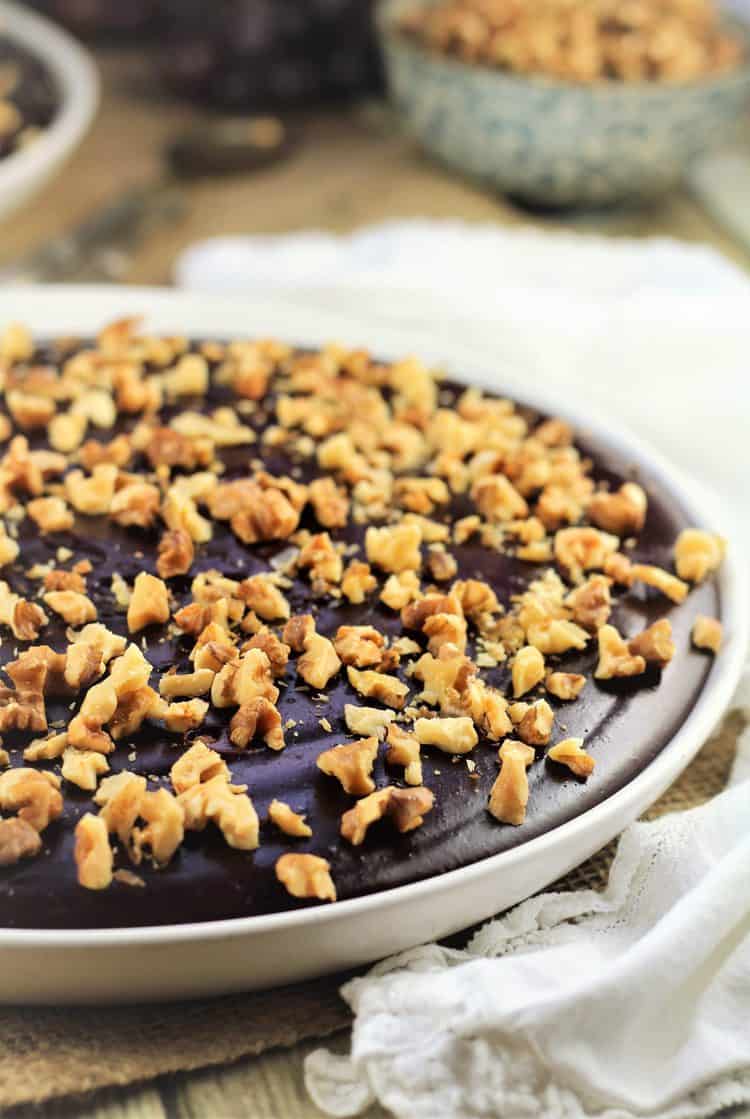
My mission to find grape must!
My mission to recreate this recipe began with the search for grape must! Unfortunately we stopped making wine at our house when my father passed away twelve years ago. However I'm lucky enough to live near a city where wine making is common at this time of year. So, I scoured Montreal for a vendor who was willing to sell me only one wood crate of wine grapes, and this was not an easy task. But alas, I found a kind soul who agreed not only to sell me one crate, but he arranged to have them crushed for me as well.
I hurried home with a large plastic bucket containing 16 liters of grape must. Next I immediately set out to transfer it to glass gallons and refrigerate it until I was ready to proceed with this recipe. If I had left it out at room temperature, inevitably the fermentation process would begin.
The following morning I began the process of preparing a farinata, at last. By the way, in case you're wondering, yes I made lots of farinata with all that grape must!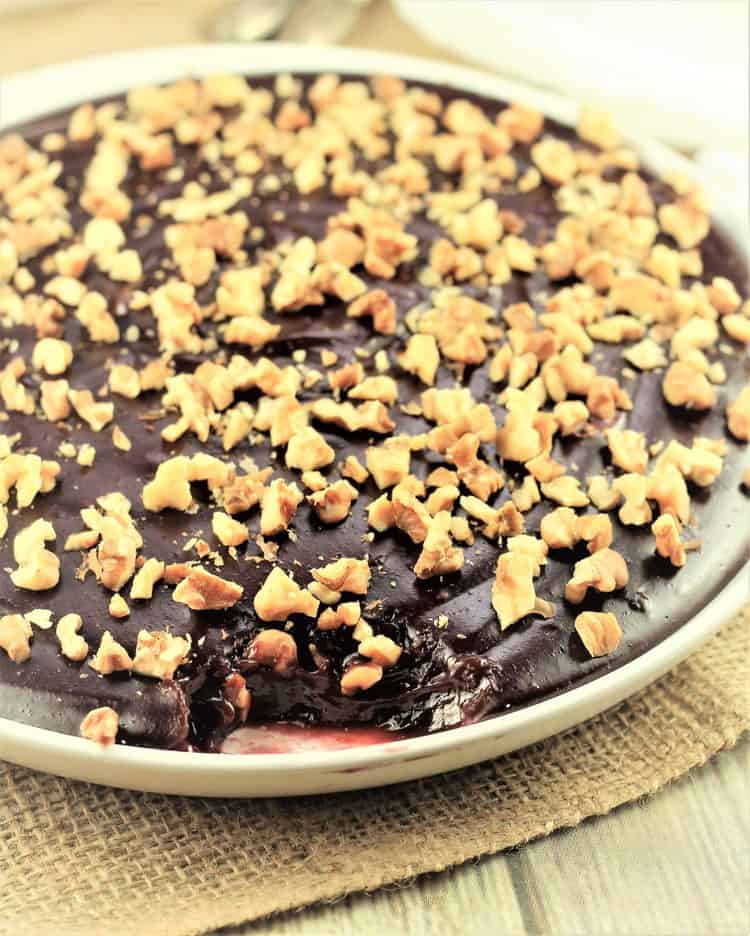
How to make Sicilian Grape Must Pudding (mostarda di uva)
You'll find the complete printable recipe card at the end of this post. The following is step by step instructions with images to guide you.
Use a fine mesh sieve to strain the grape must which will without a doubt contain bits of grape skins, seeds or other particles. I strained mine four times. Alternately, it may also be boiled immediately and strained at the end of cooking. Both methods work well.
Here is what it looked like before I strained it:
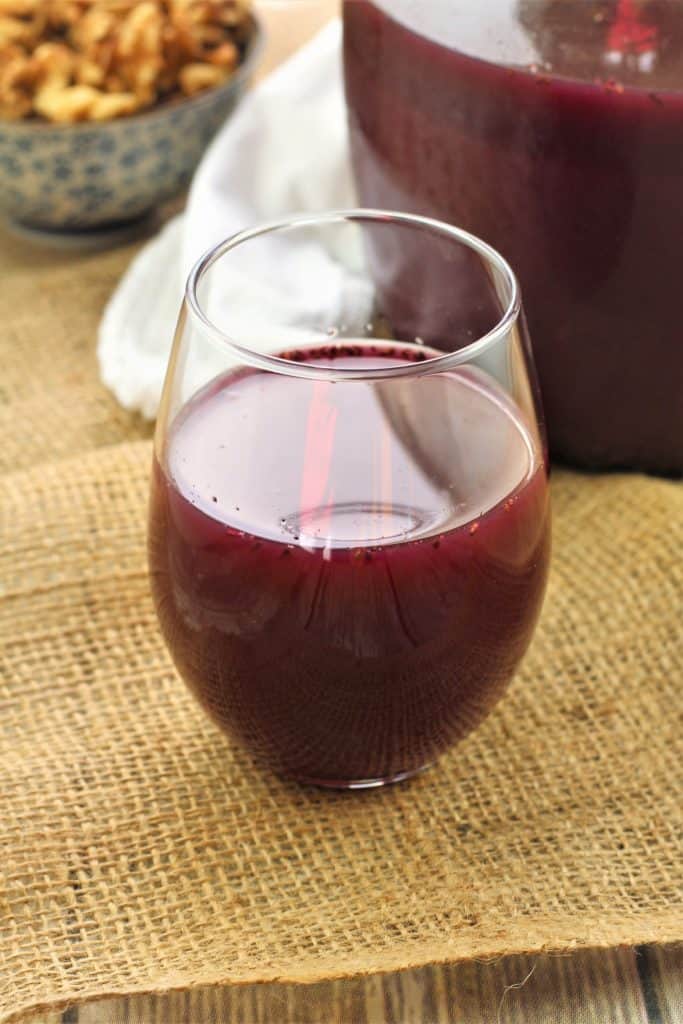
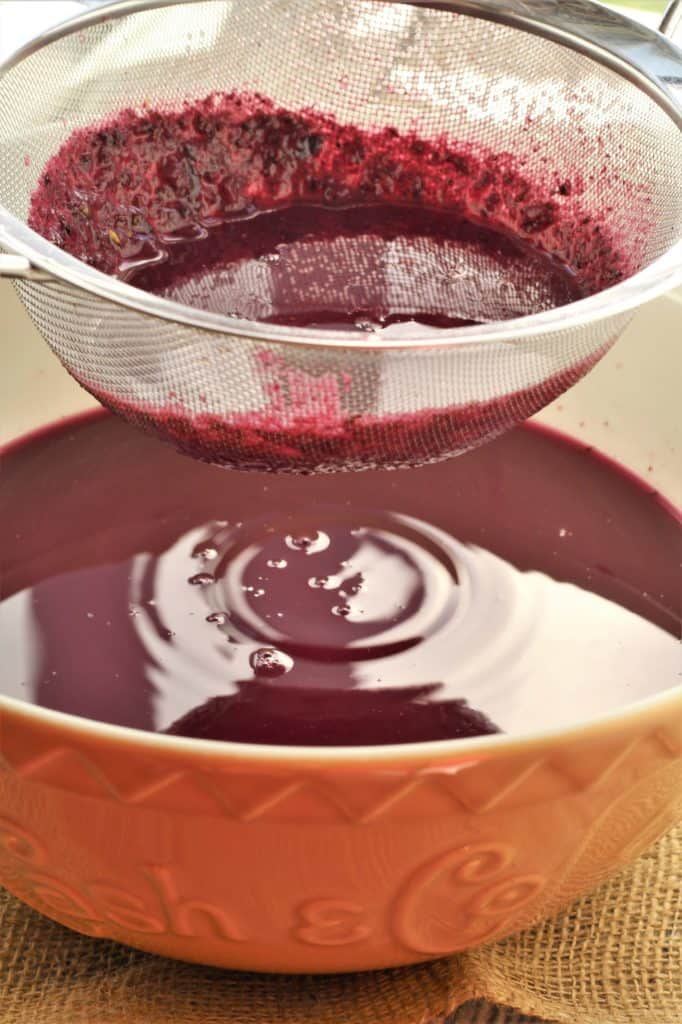
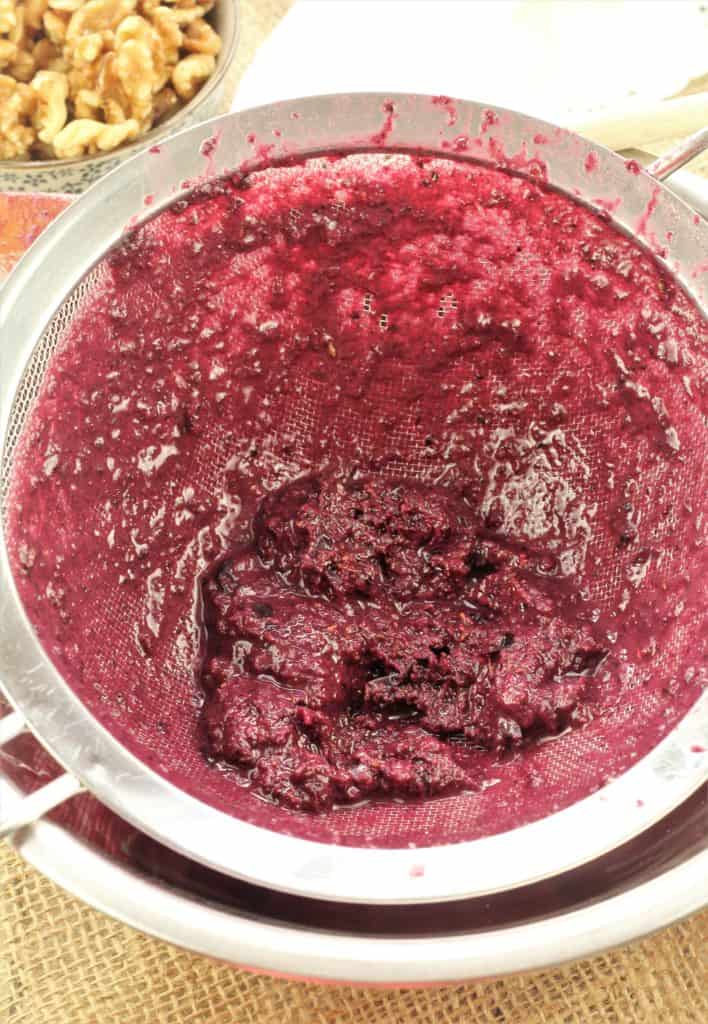
And here it is after I strained it.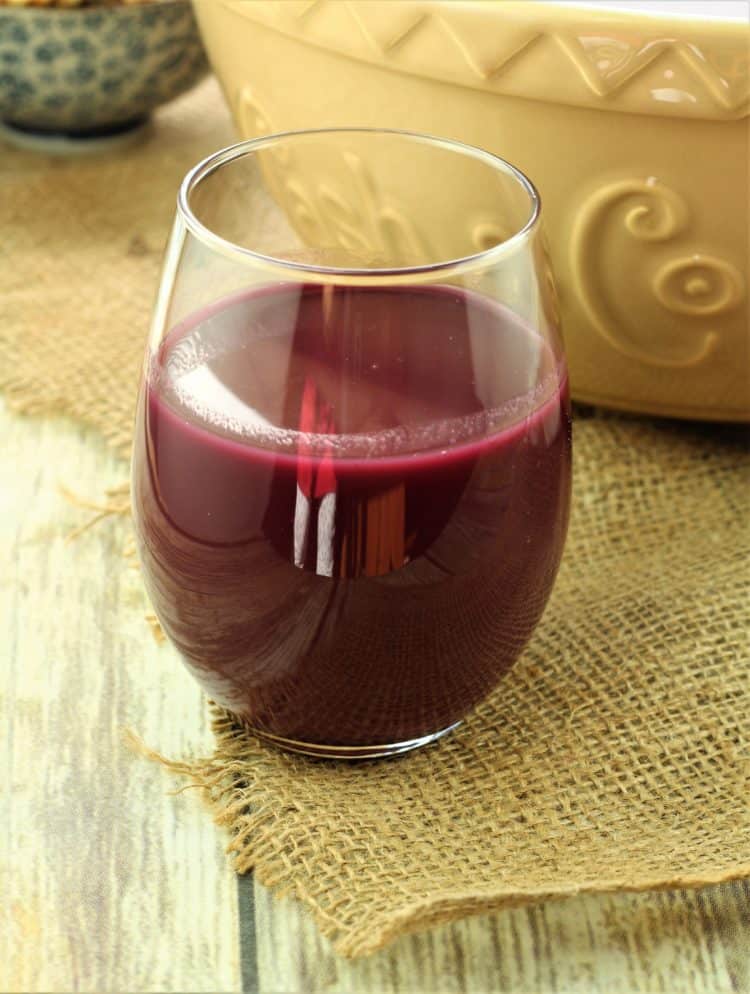
Place the grape must in a large heavy bottomed pot and bring to a boil. Use a slotted spoon to skim off the foam that comes to the surface. Lower to medium heat and boil until it has reduced by half. This took me about an hour and fifteen minutes. Transfer to a bowl and let cool slightly before placing it in the refrigerator to cool completely, at least four hours or overnight.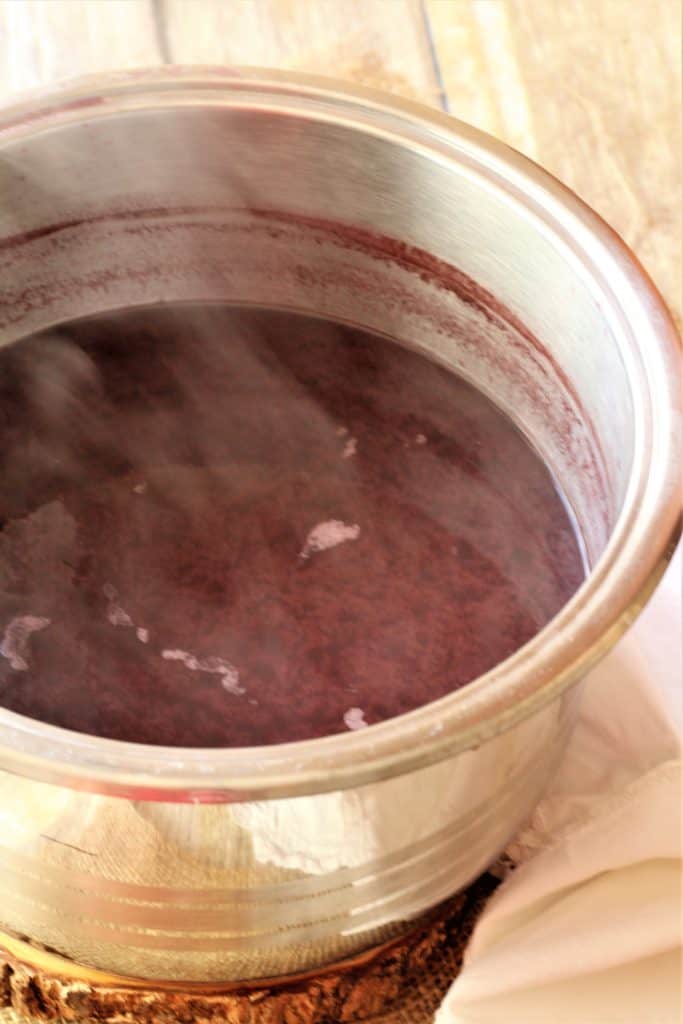
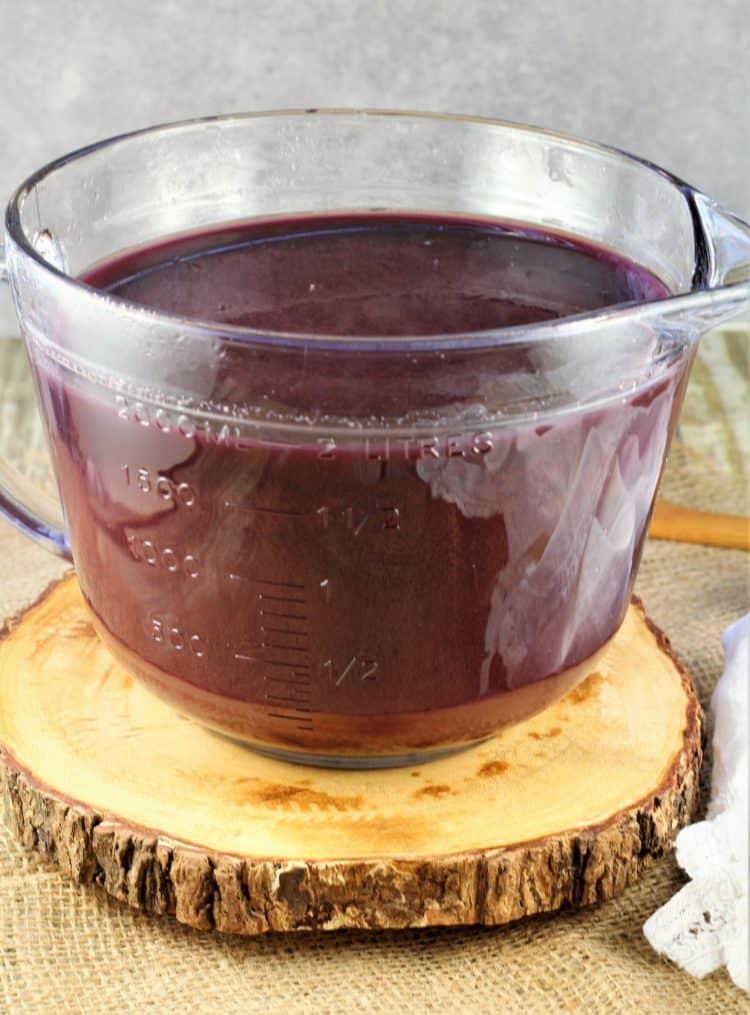
When you are ready to make the farinata, transfer most of the reduced grape must to the same large pot as before. Whisk cornstarch into the remaining grape must in the bowl until completely smooth.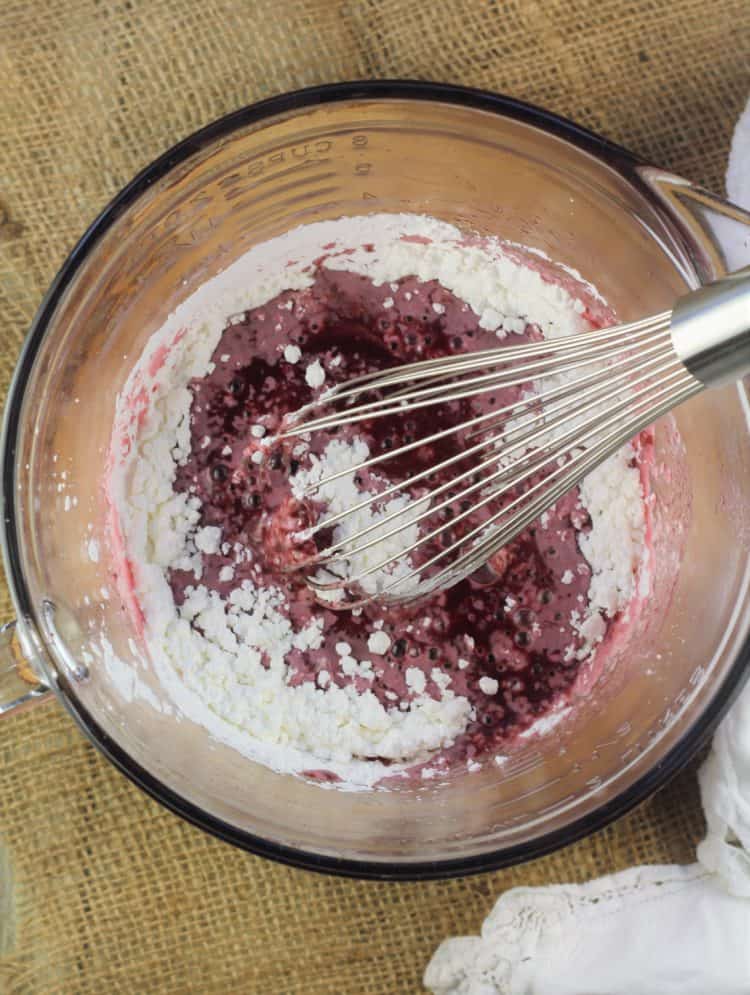
Whisk this mixture into the pot with the rest of the grape must and add cinnamon.
Bring to a boil and cook on medium high heat, whisking constantly, until thickened (about 5-6 minutes).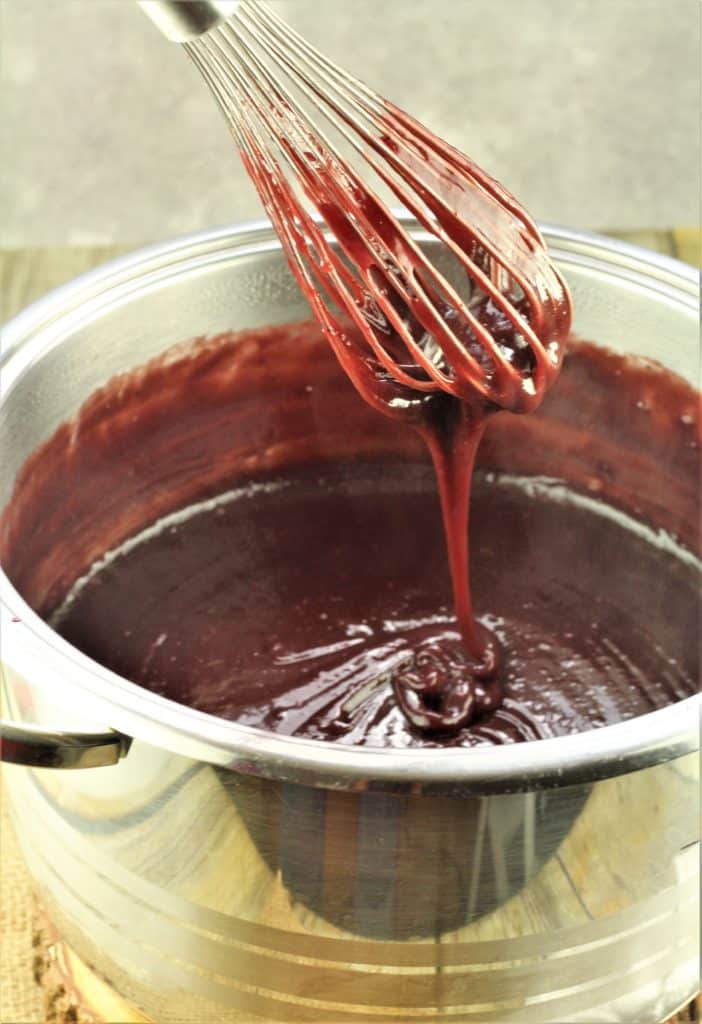
Ladle the mixture onto dinner plates immediately as it will begin to set. I filled two large 10 inch plates. Top with toasted chopped nuts of your choice such as walnuts, almonds, hazelnuts or pistachios. I chose walnuts as that is what my aunt also topped her farinata with.
Transfer to the refrigerator to cool completely. Spoon onto individual plates to serve. 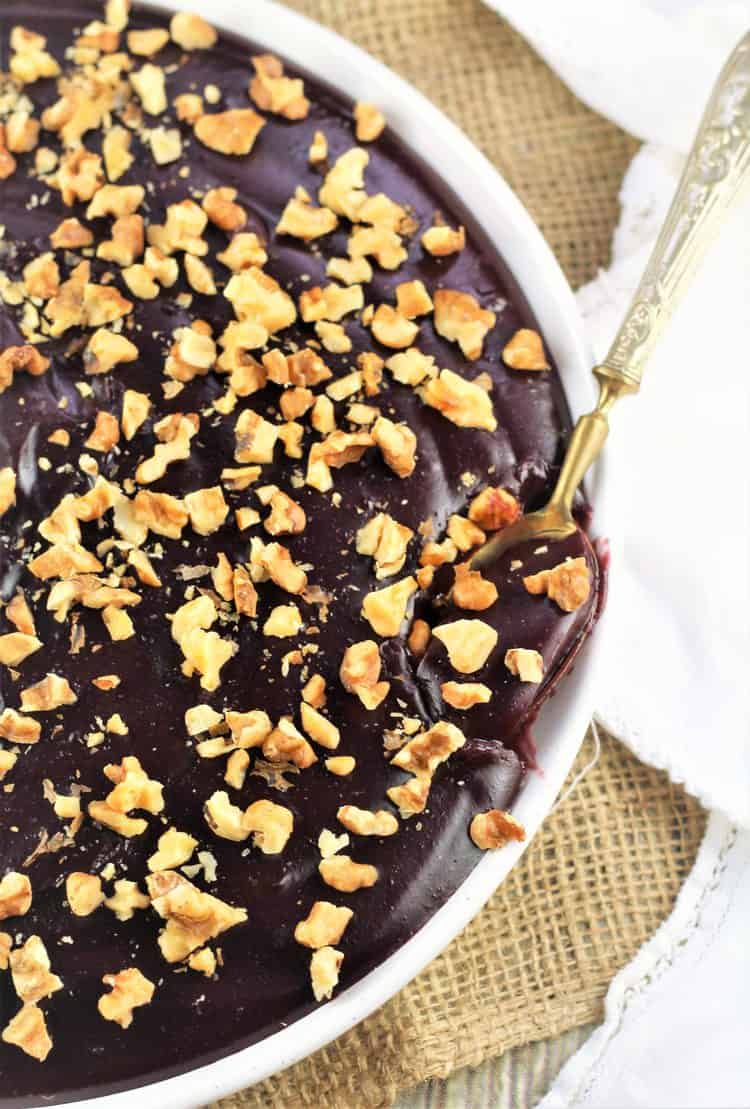
Tips and suggestions:
- If you don't have access to freshly pressed grape must another alternative would be to buy approximately 2.5 kg of wine grapes and pass them through a food mill.
- This recipe makes 2 -10 inch dinner plates full but the recipe can be easily halved.
- Keep the grape must refrigerated until you are ready to prepare your farinata.
- Garnish with toasted nuts of your choice such as almonds, hazelnuts or pistachios.
- This dish keeps well in the fridge for 3-4 days.
If you give this ancient Sicilian recipe a try, please let me know by commenting below. Feel free to Pin the recipe for later. Buon appetito!
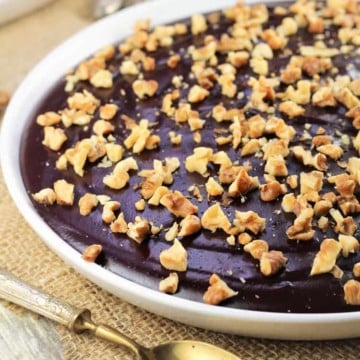
Sicilian Grape Must Pudding (a farinata)
Ingredients
- 4 litres grape must from red wine grapes freshly pressed (about 16 cups)
- 100 grams walnuts toasted and chopped (about 1 cup)
- 200 grams cornstarch (1 ½ cups)
- 2 teaspoon cinnamon
Instructions
- Use a fine mesh sieve to strain the grape must which will without a doubt contain bits of grape skins, seeds or other particles. I strained mine four times. Alternately, it may also be boiled immediately and strained at the end of cooking. Both work well.
- Place the grape must in a large heavy bottomed pot and bring to a boil. Use a slotted spoon to skim off the foam that rises to the surface. Lower to medium heat and boil until it has reduced by half. This took me about an hour and fifteen minutes. Transfer to a bowl and let cool slightly before placing it in the refrigerator to cool completely, at least four hours or overnight.
- Once it has completely cooled, transfer most of the reduced grape must to the same large pot as before. Whisk cornstarch into the remaining grape must until completely smooth.
- Whisk this mixture into the pot with the rest of the grape must and add cinnamon. Bring to a oil and cook on medium high heat, whisking constantly, until thickened (about 5-6 minutes).
- Ladle the mixture onto dinner plates immediately as it will begin to set. I filled two large 10 inch plates. Top with toasted chopped nuts of your choice. I chose walnuts as that is what my aunt also topped her farinata with.
- Transfer to the refrigerator to cool completely. To serve, spoon onto individual plates.
Notes
- If you don't have access to freshly pressed grape must another alternative would be to buy approximately 2.5 kg of wine grapes and pass them through a food mill.
- This recipe makes 2 -10 inch dinner plates full but the recipe can be easily halved.
- Keep the grape must refrigerated until you are ready to prepare your farinata.
- Garnish with toasted nuts of your choice such as almonds, hazelnuts or pistachios.
- This dish keeps well in the fridge for 3-4 days.


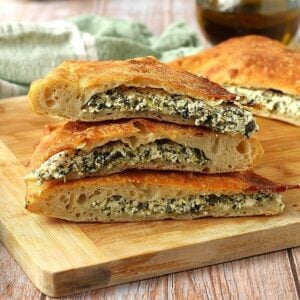
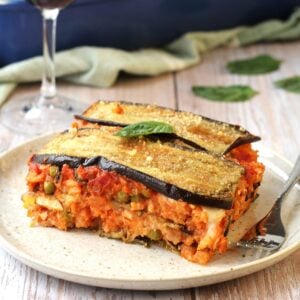
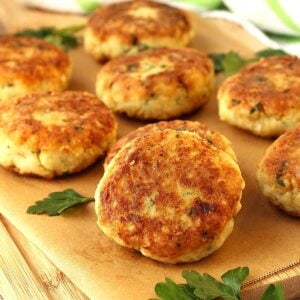

Grace Bonanno J.
Hi Nadia,,,I have loved looking through your recipes and appreciate your commitment to passing along the southern Italian culture through recipes and shared stories. I remember 'mustarda' from my childhood and visits to our relatives in the Messina region of Sicily. I even wrote down the sketchy instructions when I was a teenager (I'm 77 now). It was clean, sifted ashes that were used to thicken the grape must. It was plated just as you did here on your site, in shallow bowls and toasted nuts (mostly almonds) were used on top. Thanks again for your wonderful, informative website...Grace
Nadia
Hello Grace, than you for sharing your memories of this dish with me! Interestingly enough, in my parent's hometown(also in the province of Messina) it was always referred to as "farinata". I have heard that in Sicily it was made with sifted ashes but here in Canada my aunt always used cornstarch and always so good! Thank you for taking the time to browse through my recipes and commenting, and happy new year to you!
Maria Turrisi
I also had a sister-in -law who always made this and her recipe died when she did. My Sicilian husband decided he wanted me to make it and for the last two years I’ve tried recipes that didn’t work until yours. I made it the first time today with only a liter of must and so I had to do the math for the cornstarch. The taste is great but it didn’t set right. I’m trying it again with more cornstarch. Thank you
Nadia
Hello Maria, I'm so glad it worked out for you and yes perhaps it does need a little more cornstarch. Thank you for your kind feedback!
Sandy
My dad used to make this every October when he made his own wine in our basement. He was from Messina. I loved this dish so much as a child and am glad to see this recipe because my dad’s recipe also died with him. This version is a little different from his but at least it’s a place to start. Thank you!!
Nadia
Hi Sandy, most of us Sicilians grew up with some relative or other making this each fall when they made the wine, such wonderful memories! Do let me know if you give it a try and thank you for your comment!
Claudia
Hi Nadia,
My Sicilian grandmother, who immigrated to this country from Catania in 1914 at a very young age with her parents and settled in Lawrence, Massachusetts, made this "mustarda" quite often. It was one of my favorite things as a kid. From what I can remember, she used the grapes from the vine in her back yard. They were sweet Concord grapes—not wine grapes—but she probably just figured she'd use what she had. She would serve it as a pudding, but would also spread some of it out in a sheet pan to dry. It was like fruit jerky! I never saw her garnish it with nuts, but I do remember cinnamon. I just made some myself using Concord grapes which are in season now in New England. The smell and taste has transported me back to my childhood!
Nadia
Hi Claudia, funny you should mention it, my cousin in Sicily also uses the Concord grapes she has growing her backyard to make this just like you did! My mom told me about the dried version of it, it sounds like it must have been like jerky as you mentioned. She looked forward to enjoying it as this was basically their candy at the time, it was a rare treat. Like you, this dish brings me back to my childhood. Thank you for sharing your memories with me!
Michael Colletti
My grandfather would make his own wine and used to make something similar but it was more of a sugary version and i think they used pectin instead of cornstarch. This is one of my favorite things to eat as a child but none of my family make it since he passed away. Its great to see this recipe as i always talk about this but never seen a recipe for it. Thank you
Nadia
Hello Michael, it is possible he used pectin to thicken the mixture. It is unfortunately a lost tradition in our family but I wanted to revive it and it was a big hit. Thank you for your comment!
Gianfranca
My mum always made this. Her recipe was so simple...for every cup of musto she added one tablespoon of corn flour....the cornflour is stirred into the musto first and then it is heated until it thickens and poured onto a plate and topped with nuts. My mum would also freeze the musto in empty margarine containers so that she could make mustarda any time of the year.
Nadia
Hi Gianfranca, thanks for sharing this with me. I never knew it could be frozen but I'll definitely keep this in mind next time I make it. Thanks again!
P. E.
Hi,
I love your story and recipes. Thank you very much for your willingness to share. On a recent trip to Siracusa, Sicily, my friend's mom made this delicious dessert for us and spoke of the ashes used in the making. She said it was a dessert from times of old and I felt transported into memories of Sicilia while enjoying this precious treat. When I saw it on your page, it just reaffirmed that I found the right site for Sicilian recipes. Grazie!
Nadia
Hello P.E. and thank you for your lovely comment! I have never tried this recipe with the ashes, it is not a technique my aunt used here in Canada. But I'm glad to hear you had the opportunity to sample it in Sicily, it must have been amazing! So glad you stumbled upon my website and thanks again!
Sarina
Hi Nadia,
I make this Mostarda myself. I remember it as a small child in Sicily. I have known people who have made it here in Australia but my mother never did even though my father made his own wine until he became too old to do it anymore. I also wanted to continue these traditional recipes that are disappearing with the older generation. I got it from an older relative and I don’t bother with adding the ashes, it just seems like too much trouble. I also find that it’s not needed as the juice is quite sweet and not acidic. Now I have a cheat’s version that is simpler to make. I just use pure grape juice as no one I know makes wine anymore. It has to be pure grape juice with no preservatives or anything added. You can usually find this in supermarkets or health food stores. The recipe I was given uses plain flour not cornstarch. The ratio is 100 grams of flour per 1 litre of juice. You boil the juice and gradually add the flour always stirring so you don’t get any lumps. As it starts to thicken add the cinnamon powder and I also like to use powdered cloves. A teaspoon of each is enoughas I usually make 2 litres at a time. At this stage you can also add the nuts or alternatively add them when it’s plated up. You can eat it warm or put it into smaller moulds to dry in the sun. Depending on the weather this would probably take a few days to a week. After a couple of days the Mostarda should be firm enough to be taken out of the moulds and turned regularly so it drys evenly on both sides. Also protect it with a net so you don’t get insects on it. That’s my simple version and it still tastes very yummy.
Nadia
Hello Sarina, thank you for sharing your recipe. It's good to know because grape must is definitely not easy to find unless you're pressing your own grapes for wine. I will definitely keep this in mind for next time I want to try making mostarda. Thanks again!
Rocco
HI Nadia,
Thanks for posting this recipe. My mother who is from Calabria, used to make this when I was a child here in Australia. She hasn't made it for a while now as we're not near anyone who makes wine anymore.
We referred to it as Mustarda and also used walnuts.
I used to love this as a kid and now you've peaked my interest to make this myself and carry on the tradition. Thank you!
Nadia
Hi Rocco you are quite welcome! You don't know how long I've been wanting to make it and I'm glad I finally got around to it. I guess people from my mother's town are the only ones who call it farinata! I must try and figure out where that word comes from. Hope you give it a try!
Lina Arduca
Hi Nadia, I am thrilled to find your recipe a Farinata, the same as my mother used to make every year during winemaking we are from Calabria and call it Mustarda. My husband makes wine every year and I look forward to putting aside a large amount of grape must. I boil and reduce it to a syrup and leave some for my Mustarda and the rest once cooled I put it away in a bottle and store it in the fridge for months, I use it to marinade Pork Ribs, Roasts, drizzle on ice cream and ricotta etc similar to vincotto it’s Delicious !! Thank you from Australia
Nadia
Hi Lina, it seems like those from my parent's home town are the only ones who call it farinata! I'm glad you were glad to find my recipe and thanks for sharing your idea of what to do with the rest that I refrigerated. I have not yet found a way to use and your idea of marinating ribs sounds delicious! Thank you!
Stefania
Hi Nadia,
Thank you for sharing this and for all of your wonderful recipes! I have been trying to track down and learn some of my family’s (Bianca Villa) traditional Sicilian dishes. My Nonna used to make a recipe she called mostaccioli (not sure if I’m spelling that right) with honey. I believe in Sicily, she would make it with the syrup from Fico d’india but when she moved to the States, honey was the closest substitute she could find. I was fascinated when I read that you were trying a version of this recipe where you would dry out the pudding and cut into squares, because this sounds very much like the mostaccioli that I remember from my childhood. It had a slightly chewy texture and was topped with nuts- delicious! After scouring the internet, I found a recipe for a version made with grape must and so I made a batch this Christmas after finding a bottle of grape must on Amazon. I have been having so much trouble finding any info about this recipe that I was thrilled to see your post, which very much seems like a variation on the sweet that my family enjoyed every year for Christmas. I am excited to try many of your dishes!
Nadia
Hi Stefania, thank you for your lovely comment! I have heard of mostaccioli but I have never made them before. I'm glad to hear you found some grape must on Amazon, I didn't think of looking there! It took me a while to hunt down a wine grape vendor who would sell me such a small amount to make this recipe but it was worthwhile! Thanks again and happy Easter to you!
John
Yes we always made this at Christmas! My family is from Messina and my dad would make it with tart grape juice using cornstarch. But he would talk about how is was made from the wine pressings.
I am making it this year! Thanks for the post and recipe. We also called it Mustarda.
Nadia
Hi John, I have learned that the only people who call this dish 'farinata' are those from my mom's home town! Otherwise it sounds like the exact same recipe. Hope yours turns out as you expected. Enjoy!
Pat
Very interesting heritage recipe, Nadia. My husband's family never made it even though my father-in - law always made his own wine every year-- they were from Calabria. They would mix musto with pig blood and other ingredients to make sanguinaccio dolce.
Nadia
Hi Pat, from the feedback I've received so far it really seems to be specific to Sicily. In fact I have not encountered many people who know of it at all! Yes, I do know about the sanguinaccio but I must admit I've never tasted it. Are you a fan?
Anna Bucciarelli
I have never heard of this; my husband, who passed away in 2011, and his family (Abbruzese) made wine each year until his death and never have any of them even mentioned it. In truth, I very much doubt that the men in the family would give up even a fistful of grapes taken from their precious wine stash :>). I live about 35 miles north of Boston where the grape market is, can only drive locally now that I've turned 83 and am wary about driving to places I'm not sure of,, and strongly doubt I would be sold only one box (usually about 60 lbs.), so don't think I will ever make this. I am intrigues, however, and wish I lived near you so I could have a bite of your effort. I so admire your research and effort in providing us with historical recipes from Sicily. As I've written to you previously, my mama was from Naples, papa from Calabria, but I strongly recognize our cooking in your recipes, maybe some minor differences but not much given papa taught mama to cook (she was 17 when they married) and Calabria's cooking is very similar to that of Sicily in many ways I think. Thank you Nadia, for your commitment and industry in providing us with wonderful food and the history surrounding it.
Nadia
Hi Anna, as far as I know this recipe is known mainly in Sicily. And yes, obtaining this one case of crushed grape must was definitely a challenge but so worthwhile. An option would be to buy grapes and pass them through a food mill in order to obtain the must to make this recipe. And regarding the guitar to make the pasta, I've seen that as well. The shape is slightly different from the maccaruna. Pasta alla chitarra has a more squared shape whereas the maccaruna are round. And I think you could probably purchase one, have you checked online?
Nancy
Hi Nadia,
This recipe is nostalgic of when my dad would make wine during the fall season. For my Sicilian (Messinesi) parents making this wine pudding which we called MUSTARDA was a tradition. Nadya, It's wonderful to see these recipes and there are so many skills of foodmaking, preserving that I also acquired as a I saw my mom and dad keep them in their new home country. The advantages are so many however, the result of not passing them to our children, the recipe or skill will be lost. I'm glad my daughter is continuing some of our traditions.
Nadia
Hi Nancy, it's so interesting to learn that everyone else refers to this as mostarda except for those from my parent's home town. They simply call it 'a farinata'. I'm so enjoying learning about the differences in recipes from one area of Sicily to another. I was so excited to finally learn how to make this recipe and best of all my family enjoyed it! Thanks for your comment!
mmpellegrino
I remember my mum making la mustarda' it was made with the ashes of the woodwhen they prued the grapes I believe this also Helped to sweeten and thicken once cooked it was put in molds the next day it was taken out of the mold and left out in the sun to dry and be kept for when needed I don t have a recipe I just remember that when we immigrated to Australia mum still made the mustarda this way
Nadia
Hello, I did read about the use of ashes in the recipe but my mom was not aware of this. Apparently it helped reduce the level of acidity. My mom also mentioned that my nonna would dry it in the sun and then they stored in for long periods of time. Of course we don't have that Sicilian sun so I attempted to dry mine in the oven. Thanks for sharing this with me!
Margaret Arangio
Sorry for all my errors. The mustata will start forming mold not mild! Darn autocorrect!
Nadia
No worries Margaret I understood. And thanks for the tip, I just transferred it to the oven right now. I’ll post an update!